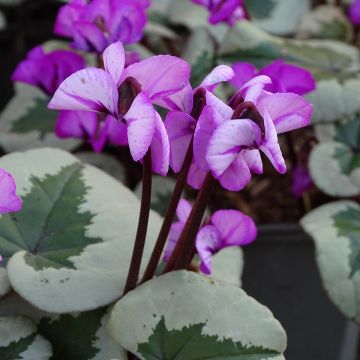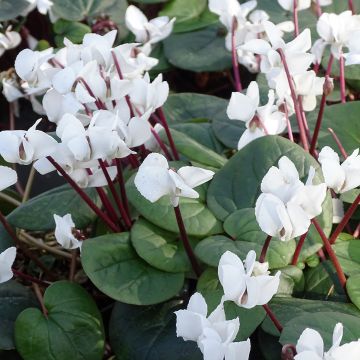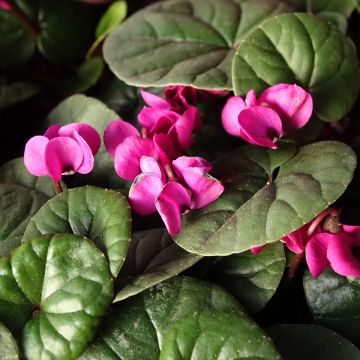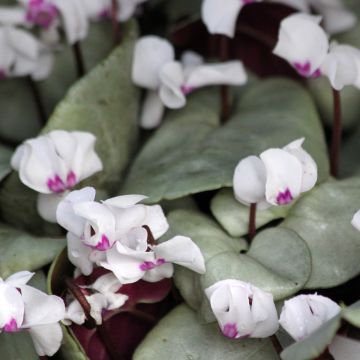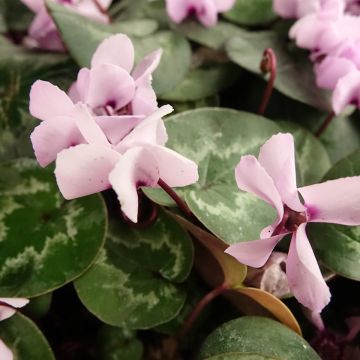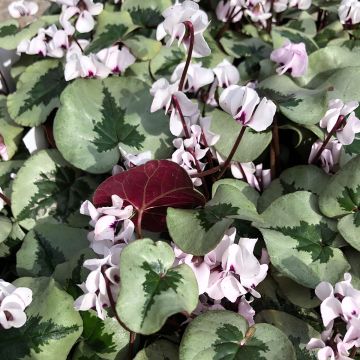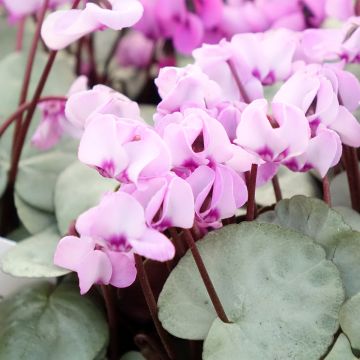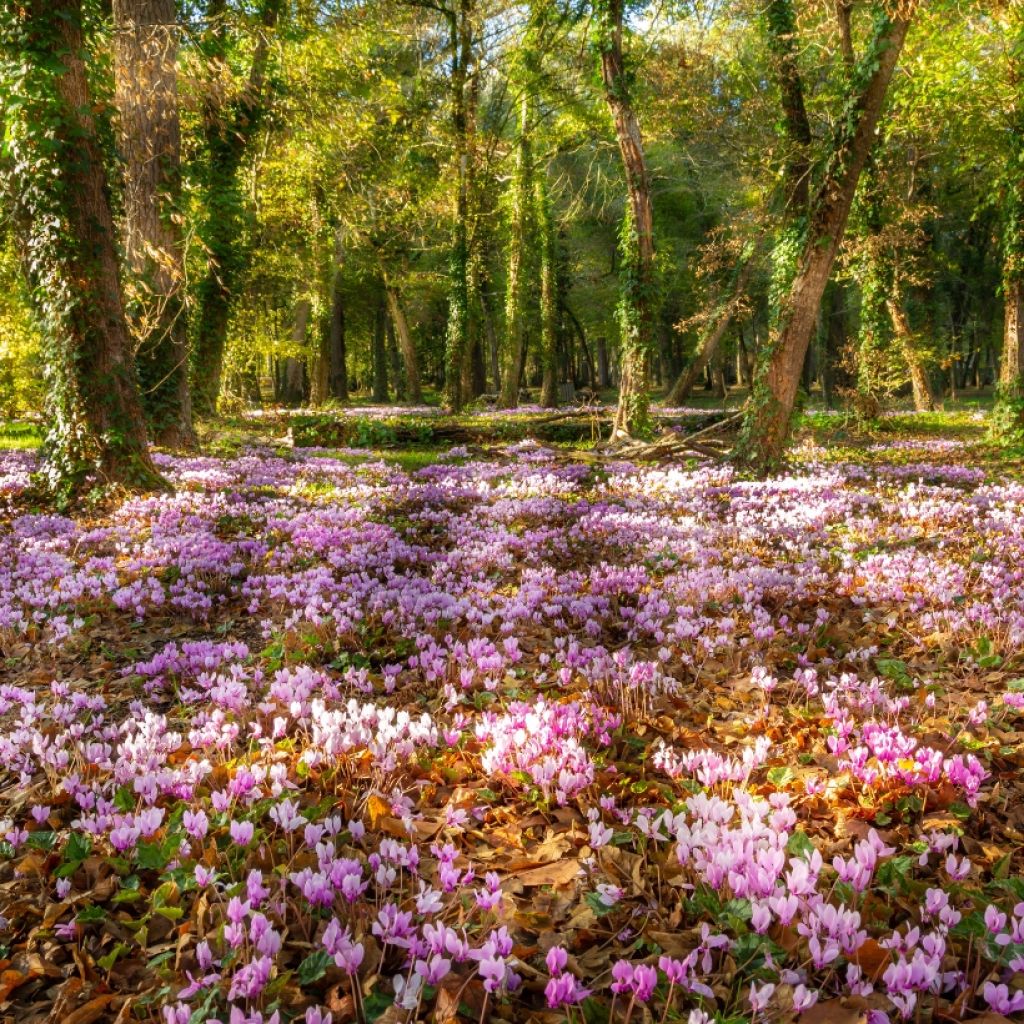

Autumn Flowery Carpet - Pink and White Naples Cyclamen
Autumn Flowery Carpet - Pink and White Naples Cyclamen
Cyclamen hederifolium Rose, Album
This plant carries a 6 months recovery warranty
More information
We guarantee the quality of our plants for a full growing cycle, and will replace at our expense any plant that fails to recover under normal climatic and planting conditions.
From €5.90 for pickup delivery and €6.90 for home delivery
Express home delivery from €8.90.
Does this plant fit my garden?
Set up your Plantfit profile →
Collection items (15 plants)
Description
We offer you the Autumn Flowering Carpet Collection to celebrate the beauty of the Naples Cyclamen in pink and white. This hardy little plant has few rivals when it comes to beautifying the garden from late summer to autumn. Its heart-shaped leaves, often marbled with silver patterns, form a dense and decorative carpet until spring. The small yet elegant flowers gracefully rise above the foliage, adding a touch of colour to shaded areas. Plant the bulbs in well-drained soil where they can thrive without maintenance or watering in summer.
This Autumn Flowering Carpet Collection consists of two varieties of Naples Cyclamen, perfectly matched to create a charming autumn tableau. They are:
10 Pink Naples Cyclamen (Cyclamen hederifolium): the wild species with soft pink flowers. They rise on graceful stems about 10 to 15 cm tall. Its marbled leaves appear after the flowers, creating a decorative carpet. They disappear before summer. Flowering in August-September.
5 White Naples Cyclamen (Cyclamen hederifolium ‘Album’): Similar in size and habit to the pink variety, this cyclamen stands out with its pure white flowers, which brighten up the shaded corners of the garden. Flowering in August-September, just before the leaves appear.
The bulbs are packed and labelled separately.
The tubers of the Naples Cyclamen are ideally planted in autumn, in light, well-drained soil enriched with compost. Place them in woodland areas, along paths, or in shaded rockeries, at a rate of 15 bulbs per m², with a spacing of 15 cm between each bulb. If you choose to grow them in pots, make sure to use a mix of compost and sand for good drainage. The white and pink varieties harmonise beautifully, creating a soft mass effect.
For an enchanting autumnal display, combine these cyclamens with Carex oshimensis 'Evergold', whose yellow variegated leaves blend harmoniously with the pastel shades of the cyclamens. Plant three Carex plants per m², around the cyclamens. Add some clumps of Aster divaricatus (4 plants per m²), which bear small star-shaped white flowers in late summer. Place Christmas roses (Helleborus niger) (2 plants per m²) in the background. With their white flowers, these perennials will bring life to the carpet in winter.
Report an error about the product description
Plant habit
Flowering
Foliage
Botanical data
Cyclamen
hederifolium
Rose, Album
Primulaceae
Southern Europe
Other Cyclamen
Planting and care
Plant your cyclamen bulbs 5 cm deep in light and moderately fertile soil, rich in compost and well-drained, as cyclamen is sensitive to rot. Leave a space of 15 cm between each bulb. Place them in shade or partial shade during the summer. The smooth part of the bulbs is the bottom. If you're unsure of the planting direction, place your bulbs upright on their side, they will naturally tip over. Water moderately. Respect the summer dormancy period of the tubers, with no excess moisture. For potted plants, apply fertiliser every 15 days.
Planting period
Intended location
Care
This item has not been reviewed yet - be the first to leave a review about it.
Haven't found what you were looking for?
Hardiness is the lowest winter temperature a plant can endure without suffering serious damage or even dying. However, hardiness is affected by location (a sheltered area, such as a patio), protection (winter cover) and soil type (hardiness is improved by well-drained soil).

Photo Sharing Terms & Conditions
In order to encourage gardeners to interact and share their experiences, Promesse de fleurs offers various media enabling content to be uploaded onto its Site - in particular via the ‘Photo sharing’ module.
The User agrees to refrain from:
- Posting any content that is illegal, prejudicial, insulting, racist, inciteful to hatred, revisionist, contrary to public decency, that infringes on privacy or on the privacy rights of third parties, in particular the publicity rights of persons and goods, intellectual property rights, or the right to privacy.
- Submitting content on behalf of a third party;
- Impersonate the identity of a third party and/or publish any personal information about a third party;
In general, the User undertakes to refrain from any unethical behaviour.
All Content (in particular text, comments, files, images, photos, videos, creative works, etc.), which may be subject to property or intellectual property rights, image or other private rights, shall remain the property of the User, subject to the limited rights granted by the terms of the licence granted by Promesse de fleurs as stated below. Users are at liberty to publish or not to publish such Content on the Site, notably via the ‘Photo Sharing’ facility, and accept that this Content shall be made public and freely accessible, notably on the Internet.
Users further acknowledge, undertake to have ,and guarantee that they hold all necessary rights and permissions to publish such material on the Site, in particular with regard to the legislation in force pertaining to any privacy, property, intellectual property, image, or contractual rights, or rights of any other nature. By publishing such Content on the Site, Users acknowledge accepting full liability as publishers of the Content within the meaning of the law, and grant Promesse de fleurs, free of charge, an inclusive, worldwide licence for the said Content for the entire duration of its publication, including all reproduction, representation, up/downloading, displaying, performing, transmission, and storage rights.
Users also grant permission for their name to be linked to the Content and accept that this link may not always be made available.
By engaging in posting material, Users consent to their Content becoming automatically accessible on the Internet, in particular on other sites and/or blogs and/or web pages of the Promesse de fleurs site, including in particular social pages and the Promesse de fleurs catalogue.
Users may secure the removal of entrusted content free of charge by issuing a simple request via our contact form.
The flowering period indicated on our website applies to countries and regions located in USDA zone 8 (France, the United Kingdom, Ireland, the Netherlands, etc.)
It will vary according to where you live:
- In zones 9 to 10 (Italy, Spain, Greece, etc.), flowering will occur about 2 to 4 weeks earlier.
- In zones 6 to 7 (Germany, Poland, Slovenia, and lower mountainous regions), flowering will be delayed by 2 to 3 weeks.
- In zone 5 (Central Europe, Scandinavia), blooming will be delayed by 3 to 5 weeks.
In temperate climates, pruning of spring-flowering shrubs (forsythia, spireas, etc.) should be done just after flowering.
Pruning of summer-flowering shrubs (Indian Lilac, Perovskia, etc.) can be done in winter or spring.
In cold regions as well as with frost-sensitive plants, avoid pruning too early when severe frosts may still occur.
The planting period indicated on our website applies to countries and regions located in USDA zone 8 (France, United Kingdom, Ireland, Netherlands).
It will vary according to where you live:
- In Mediterranean zones (Marseille, Madrid, Milan, etc.), autumn and winter are the best planting periods.
- In continental zones (Strasbourg, Munich, Vienna, etc.), delay planting by 2 to 3 weeks in spring and bring it forward by 2 to 4 weeks in autumn.
- In mountainous regions (the Alps, Pyrenees, Carpathians, etc.), it is best to plant in late spring (May-June) or late summer (August-September).
The harvesting period indicated on our website applies to countries and regions in USDA zone 8 (France, England, Ireland, the Netherlands).
In colder areas (Scandinavia, Poland, Austria...) fruit and vegetable harvests are likely to be delayed by 3-4 weeks.
In warmer areas (Italy, Spain, Greece, etc.), harvesting will probably take place earlier, depending on weather conditions.
The sowing periods indicated on our website apply to countries and regions within USDA Zone 8 (France, UK, Ireland, Netherlands).
In colder areas (Scandinavia, Poland, Austria...), delay any outdoor sowing by 3-4 weeks, or sow under glass.
In warmer climes (Italy, Spain, Greece, etc.), bring outdoor sowing forward by a few weeks.





































